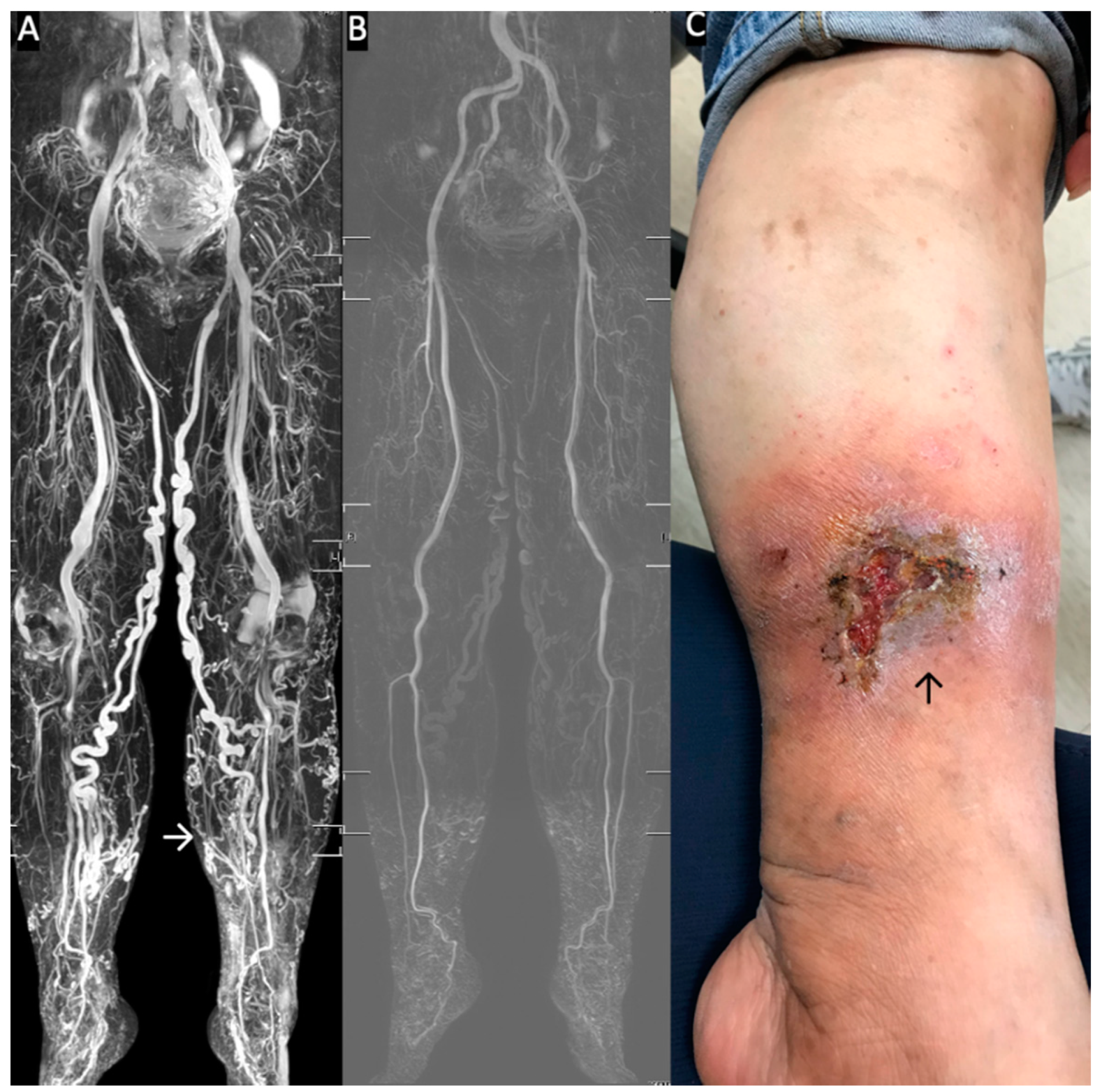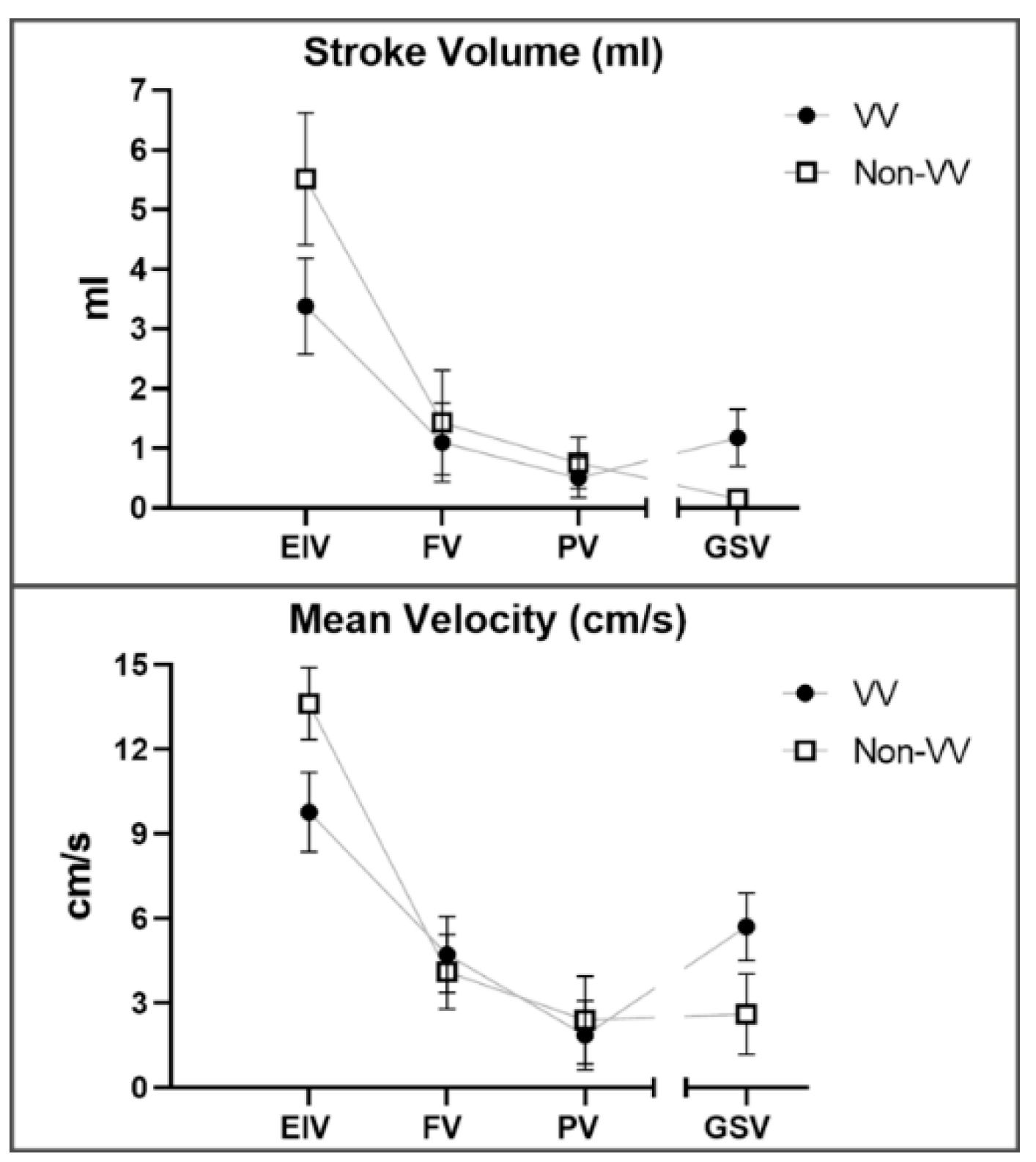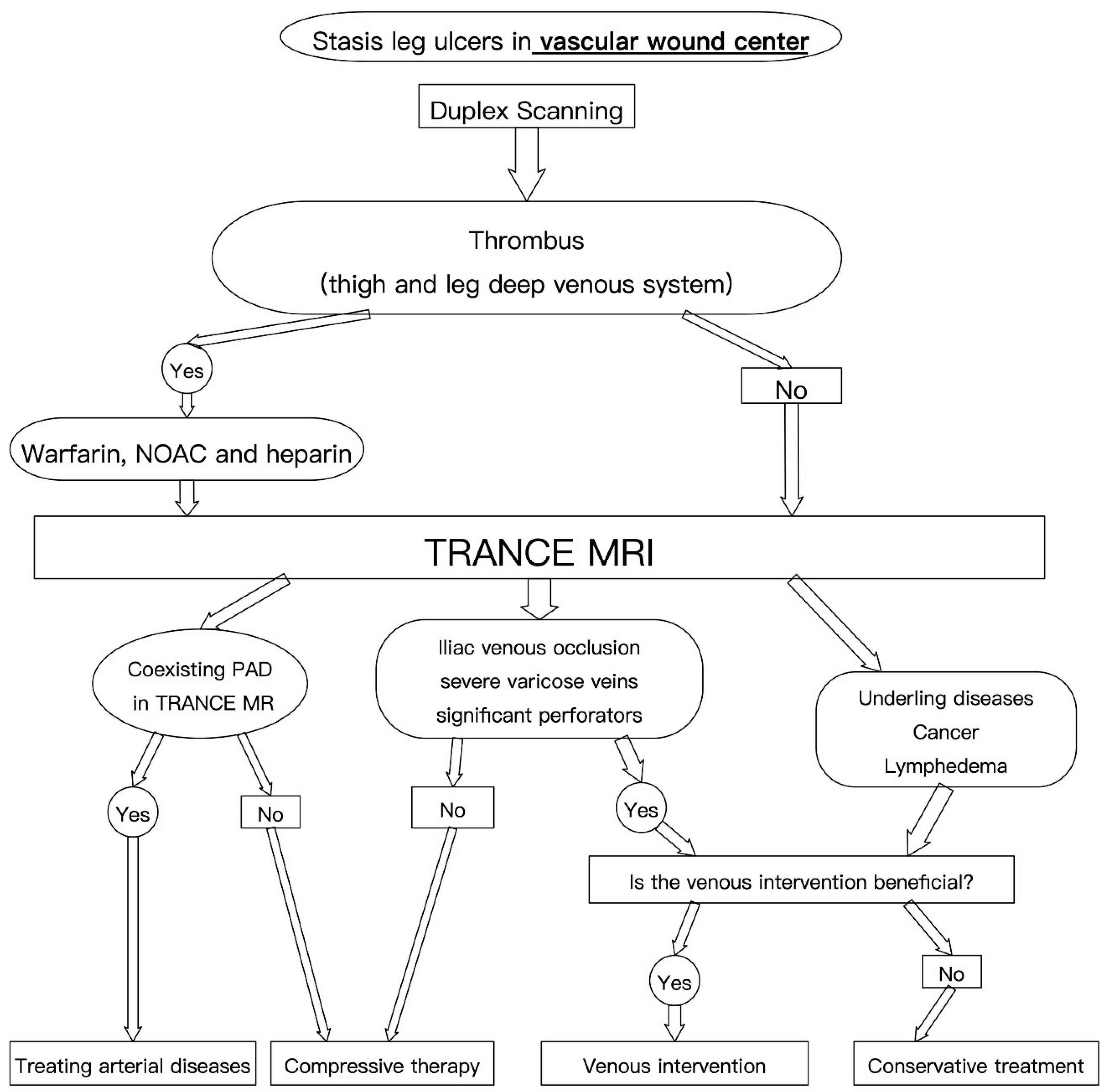Stasis Leg Ulcers: Venous System Revises by Triggered Angiography Non-Contrast-Enhanced Sequence Magnetic Resonance Imaging
Abstract
1. Background
2. Materials and Methods
2.1. Patients
2.2. MRI Acquisition
3. Results
4. Discussion
Study Limitations
5. Conclusions
Supplementary Materials
Author Contributions
Funding
Acknowledgments
Conflicts of Interest
Abbreviations
| 3D | three-dimensional |
| CT | computed tomography |
| CTA | computed tomography angiography |
| DVT | deep venous thrombosis |
| FOV | field of view |
| GSV | great saphenous vein |
| IR | inversion recovery |
| IRB | institutional review board |
| MRI | magnetic resonance imaging |
| MRV | magnetic resonance venography |
| NSF | nephrogenic systemic fibrosis |
| STIR | short tau inversion recovery |
| TE | echo time |
| TOF | time-of-flight |
| TR | repetition time |
| TRANCE-MRI | triggered angiography non-contrast-enhanced MRI |
| TSE | turbo spin-echo |
| US | ultrasonography |
| VV | varicose vein |
| SU | stasis venous ulcer |
References
- Bonkemeyer Millan, S.; Gan, R.; Townsend, P.E. Venous Ulcers: Diagnosis and Treatment. Am. Fam. Physician 2019, 100, 298–305. [Google Scholar]
- Star, A. Differentiating Lower Extremity Wounds: Arterial, Venous, Neurotrophic. Semin. Interv. Radiol. 2018, 35, 399–405. [Google Scholar] [CrossRef]
- Lim, C.S.; Baruah, M.; Bahia, S.S. Diagnosis and management of venous leg ulcers. BMJ 2018, 362, k3115. [Google Scholar] [CrossRef] [PubMed]
- Bradley, W.G., Jr.; Waluch, V. Blood flow: Magnetic resonance imaging. Radiology 1985, 154, 443–450. [Google Scholar] [CrossRef] [PubMed]
- Chen, C.W.; Tseng, Y.H.; Lin, C.C.; Kao, C.C.; Wong, M.Y.; Lin, B.S.; Huang, Y.K. Novel Diagnostic Options without Contrast Media or Radiation: Triggered Angiography Non-Contrast-Enhanced Sequence Magnetic Resonance Imaging in Treating Different Leg Venous Diseases. Diagnostics 2020, 10, 355. [Google Scholar] [CrossRef] [PubMed]
- Huang, Y.K.; Tseng, Y.H.; Lin, C.H.; Tsai, Y.H.; Hsu, Y.C.; Wang, S.C.; Chen, C.W. Evaluation of venous pathology of the lower extremities with triggered angiography non-contrast-enhanced magnetic resonance imaging. BMC Med. Imaging 2019, 19, 96. [Google Scholar] [CrossRef]
- Mutlak, O.; Aslam, M.; Standfield, N.J. Chronic venous insufficiency: A new concept to understand pathophysiology at the microvascular level—A pilot study. Perfusion 2019, 34, 84–89. [Google Scholar] [CrossRef]
- Bjarnsholt, T.; Kirketerp-Moller, K.; Jensen, P.O.; Madsen, K.G.; Phipps, R.; Krogfelt, K.; Hoiby, N.; Givskov, M. Why chronic wounds will not heal: A novel hypothesis. Wound Repair Regen. 2008, 16, 2–10. [Google Scholar] [CrossRef]
- Morilla-Herrera, J.C.; Morales-Asencio, J.M.; Gomez-Gonzalez, A.J.; Diez-De Los Rios, A.; Lupianez-Perez, I.; Acosta-Andrade, C.; Aranda-Gallardo, M.; Moya-Suarez, A.B.; Kaknani-Uttumchandani, S.; Garcia-Mayor, S. Effectiveness of a hydrophobic dressing for microorganisms’ colonization of vascular ulcers: Protocol for a randomized controlled trial (CUCO-UV Study). J. Adv. Nurs. 2020. [Google Scholar] [CrossRef]
- Lo, Z.J.; Lim, X.; Eng, D.; Car, J.; Hong, Q.; Yong, E.; Zhang, L.; Chandrasekar, S.; Tan, G.W.L.; Chan, Y.M.; et al. Clinical and economic burden of wound care in the tropics: A 5-year institutional population health review. Int. Wound J. 2020, 17, 790–803. [Google Scholar] [CrossRef]
- Gaitini, D. Current approaches and controversial issues in the diagnosis of deep vein thrombosis via duplex Doppler ultrasound. J. Clin. Ultrasound 2006, 34, 289–297. [Google Scholar] [CrossRef]
- Reid, J.H. Multislice CT pulmonary angiography and CT venography. Br. J. Radiol. 2004, 77 (Suppl. 1), S39–S45. [Google Scholar] [CrossRef] [PubMed]
- Tamura, K.; Nakahara, H. MR Venography for the Assessment of Deep Vein Thrombosis in Lower Extremities with Varicose Veins. Ann. Vasc. Dis. 2014, 7, 399–403. [Google Scholar] [CrossRef][Green Version]
- Ruehm, S.G.; Wiesner, W.; Debatin, J.F. Pelvic and lower extremity veins: Contrast-enhanced three-dimensional MR venography with a dedicated vascular coil-initial experience. Radiology 2000, 215, 421–427. [Google Scholar] [CrossRef]
- Renard, D.; Le Bars, E.; Arquizan, C.; Gaillard, N.; de Champfleur, N.M.; Mourand, I. Time-of-flight MR angiography in cerebral venous sinus thrombosis. Acta Neurol. Belg. 2017, 117, 837–840. [Google Scholar] [CrossRef]
- Yucel, E.K.; Kaufman, J.A.; Geller, S.C.; Waltman, A.C. Atherosclerotic occlusive disease of the lower extremity: Prospective evaluation with two-dimensional time-of-flight MR angiography. Radiology 1993, 187, 637–641. [Google Scholar] [CrossRef] [PubMed]
- Suttmeyer, B.; Teichgraber, U.; Thomas, A.; Rathke, H.; Albrecht, L.; Jonczyk, M.; Verba, M.; Guttler, F.; Schnackenburg, B.; Hamm, B.; et al. Non-invasive ECG-triggered 2D TOF MR angiography of the pelvic and leg arteries in an open 1.0-tesla high-field MRI system in comparison to conventional DSA. Biomed. Tech. (Berl.) 2014, 59, 29–37. [Google Scholar] [CrossRef] [PubMed]
- Harigai, M.; Okada, T.; Umeoka, S.; Nagayama, S.; Tanaka, E.; Fujimoto, K.; Kido, A.; Takeda, K.; Togashi, K.; Sakai, Y. Non-contrast-enhanced MR venography of the upper limb: A comparative study of acquisitions with fresh blood imaging vs. time-of-flight methods. Clin. Imaging 2012, 36, 496–501. [Google Scholar] [CrossRef]
- Steffens, J.C.; Link, J.; Schwarzenberg, H.; Mueller-Huelsbeck, S.; Brinkmann, G.; Heller, M. Lower extremity occlusive disease: Diagnostic imaging with a combination of cardiac-gated 2D phase-contrast and cardiac-gated 2D time-of-flight MRA. J. Comput. Assist. Tomogr. 1999, 23, 7–12. [Google Scholar] [CrossRef]
- Gurel, K.; Gurel, S.; Karavas, E.; Buharalioglu, Y.; Daglar, B. Direct contrast-enhanced MR venography in the diagnosis of May-Thurner syndrome. Eur. J. Radiol. 2011, 80, 533–536. [Google Scholar] [CrossRef]
- Ruehm, S.G.; Zimny, K.; Debatin, J.F. Direct contrast-enhanced 3D MR venography. Eur. Radiol. 2001, 11, 102–112. [Google Scholar] [CrossRef] [PubMed]
- Alfano, G.; Fontana, F.; Ferrari, A.; Solazzo, A.; Perrone, R.; Giaroni, F.; Torricelli, P.; Cappelli, G. Incidence of nephrogenic systemic fibrosis after administration of gadoteric acid in patients on renal replacement treatment. Magn. Reson. Imaging 2020, 70, 1–4. [Google Scholar] [CrossRef] [PubMed]
- Schieda, N.; Maralani, P.J.; Hurrell, C.; Tsampalieros, A.K.; Hiremath, S. Updated Clinical Practice Guideline on Use of Gadolinium-Based Contrast Agents in Kidney Disease Issued by the Canadian Association of Radiologists. Can. Assoc. Radiol. J. 2019, 70, 226–232. [Google Scholar] [CrossRef]
- Ross, M.R.; Pelc, N.J.; Enzmann, D.R. Qualitative phase contrast MRA in the normal and abnormal circle of Willis. AJNR Am. J. Neuroradiol. 1993, 14, 19–25. [Google Scholar] [PubMed]
- Forner Giner, J.; Sanz-Requena, R.; Florez, N.; Alberich-Bayarri, A.; Garcia-Marti, G.; Ponz, A.; Marti-Bonmati, L. Quantitative phase-contrast MRI study of cerebrospinal fluid flow: A method for identifying patients with normal-pressure hydrocephalus. Neurologia 2014, 29, 68–75. [Google Scholar] [CrossRef]
- Gutzeit, A.; Sutter, R.; Froehlich, J.M.; Roos, J.E.; Sautter, T.; Schoch, E.; Giger, B.; Wyss, M.; Graf, N.; von Weymarn, C.; et al. ECG-triggered non-contrast-enhanced MR angiography (TRANCE) versus digital subtraction angiography (DSA) in patients with peripheral arterial occlusive disease of the lower extremities. Eur. Radiol. 2011, 21, 1979–1987. [Google Scholar] [CrossRef]
- Suttmeyer, B.; Teichgraber, U.; Rathke, H.; Albrecht, L.; Guttler, F.; Schnackenburg, B.; Hamm, B.; de Bucourt, M. Initial experience with imaging of the lower extremity arteries in an open 1.0 Tesla MRI system using the triggered angiography non-contrast-enhanced sequence (TRANCE) compared to digital subtraction angiography (DSA). Biomed. Tech. (Berl.) 2016, 61, 383–392. [Google Scholar] [CrossRef]
- Radlbauer, R.; Salomonowitz, E.; van der Riet, W.; Stadlbauer, A. Triggered non-contrast enhanced MR angiography of peripheral arteries: Optimization of systolic and diastolic time delays for electrocardiographic triggering. Eur. J. Radiol. 2011, 80, 331–335. [Google Scholar] [CrossRef]
- Ohno, N.; Miyati, T.; Noda, T.; Alperin, N.; Hamaguchi, T.; Ohno, M.; Matsushita, T.; Mase, M.; Gabata, T.; Kobayashi, S. Fast Phase-Contrast Cine MRI for Assessing Intracranial Hemodynamics and Cerebrospinal Fluid Dynamics. Diagnostics 2020, 10, 241. [Google Scholar] [CrossRef]




| Title | Title |
|---|---|
| Male Gender (%) | 18 (78.2%) |
| Age (years old) | 61.47 ± 13.6 |
| Substance use | |
| Smoking | 3 (13%) |
| Alcohol | 1 (4.3%) |
| Areca nuts | 2 (8.6%) |
| Comorbidities | |
| Hypertension | 10 (43.4%) |
| Diabetes Mellitus | 6 (26.1%) |
| CAD | 1 (4.3%) |
| Stroke | 0 (0%) |
| Cancer | 4 (18.1%) |
| Previous deep vein thrombosis | 4 (18.1%) |
| Chronic Renal insufficiency | 1 (4.3%) |
| Kidney transplantation | 1 (4.3%) |
| Protein C, Protein S deficiency | 2 (8.6%) |
| Factor V Leiden mutation | 0 (0%) |
| Crushing limb with reconstruction | 3 (13%) |
| Previous venous surgery | |
| Stripping | 1 (4.3%) |
| GSV Ablation | 2 (8.6%) |
| sclerotherapy or phlebectomy | 1 (4.3%) |
| Venous intervention after TRANCE MR | |
| Truncal ablation of GSV | 3 (13%) |
| Venous Angioplasty | 2 (8.6%) |
| Compressive therapy | 12 (52.2%) |
| Oral anticoagulation | 14 (60.9%) |
| TRANCE MR for Venous System | Dupplex Ultrasound Scan | |
|---|---|---|
| Saphenous-femoral venous junction reflux (ultrasound) or GSV/PV > 1 (TRANCE MRI) | 9 | 9 |
| Positive for thigh and calf deep venous thrombosis | 6 | 3 |
| Double inferior vena cava | 1 | 0 |
| May-Thurner syndrome | 4 | 0 |
| Pelvic congestion | 2 | 0 |
| Peripheral arterial occlusion | 3 | 2 |
| Negative for venous lesion | 5 | 7 |
| Prominent Varicose Vein Favor Valvular Insufficiency | Venous Occlusion | No Venous Lesion | ||
|---|---|---|---|---|
| Total number | 9 | 9 | 5 | |
| Wound Location | NS | |||
| Gaiter | 9 | 8 | 5 | |
| Proximal calf | 1 | 4 | 0 | |
| Foot and sole | 0 | 1 | 1 | |
| Number | NS | |||
| Single | 8 | 4 | 2 | |
| More than 1 | 1 | 5 | 2 | |
| Depth | NS | |||
| over 5 mm | 2 | 3 | 3 | |
| Tendon exposure | 0 | 0 | 1 | |
| Recurrence | 7 | 8 | 5 | NS |
| Both legs | 1 | 4 | 1 | NS |
| Intervention | ||||
| Truncal ablation and stripping | 2 | 2 | 0 | NS |
| Venous angioplasty | 0 | 2 | 0 | NS |
| Compressive therapy | 5 | 6 | 1 | NS |
| Vacuum wound closure device | 1 | 1 | 0 | NS |
| oral anticoagulation | 2 | 9 | 3 | p = 0.002 |
© 2020 by the authors. Licensee MDPI, Basel, Switzerland. This article is an open access article distributed under the terms and conditions of the Creative Commons Attribution (CC BY) license (http://creativecommons.org/licenses/by/4.0/).
Share and Cite
Chen, C.-W.; Tseng, Y.-H.; Wong, M.Y.; Wu, C.-M.; Lin, B.-S.; Huang, Y.-K. Stasis Leg Ulcers: Venous System Revises by Triggered Angiography Non-Contrast-Enhanced Sequence Magnetic Resonance Imaging. Diagnostics 2020, 10, 707. https://doi.org/10.3390/diagnostics10090707
Chen C-W, Tseng Y-H, Wong MY, Wu C-M, Lin B-S, Huang Y-K. Stasis Leg Ulcers: Venous System Revises by Triggered Angiography Non-Contrast-Enhanced Sequence Magnetic Resonance Imaging. Diagnostics. 2020; 10(9):707. https://doi.org/10.3390/diagnostics10090707
Chicago/Turabian StyleChen, Chien-Wei, Yuan-Hsi Tseng, Min Yi Wong, Chao-Ming Wu, Bor-Shyh Lin, and Yao-Kuang Huang. 2020. "Stasis Leg Ulcers: Venous System Revises by Triggered Angiography Non-Contrast-Enhanced Sequence Magnetic Resonance Imaging" Diagnostics 10, no. 9: 707. https://doi.org/10.3390/diagnostics10090707
APA StyleChen, C.-W., Tseng, Y.-H., Wong, M. Y., Wu, C.-M., Lin, B.-S., & Huang, Y.-K. (2020). Stasis Leg Ulcers: Venous System Revises by Triggered Angiography Non-Contrast-Enhanced Sequence Magnetic Resonance Imaging. Diagnostics, 10(9), 707. https://doi.org/10.3390/diagnostics10090707





